Welcome to Eatdemy, your eating academy.
Northeastern India, with its lush green landscapes and rich cultural variety, offers a culinary world that’s as diverse as its geography. Among the many treasures that this region brings to the Indian culinary table, the dish of Smoked Pork with Taro Leaves (Vawksa Rep/Hro with Dawl Hro) stands out. It’s not just a dish; it’s a story of tradition, community, and flavor that has been passed down through generations.
The roots of this dish trace back to the traditional kitchens of the Hmar community, as well as the wider Kuki-Chin-Mizo groups. These communities, spread across the hills and valleys of Northeast India, have long relied on nature’s bounty for their daily meals. Smoked pork, for instance, isn’t just a choice of meat; it’s a preservation technique. By smoking the pork, these communities could store it for longer periods, ensuring a supply of protein even in harsh weather conditions.
Now, pair this smoked pork with dried taro leaves, and what you get is a dish that perfectly captures the essence of the Northeast. Taro, a versatile root vegetable, is widely cultivated in this region. While its roots are often boiled or fried, its leaves, especially when dried, bring a distinct earthy flavor to dishes. It’s this combination of smoky pork and earthy taro leaves that makes this dish a favorite among locals and a must-try for anyone looking to explore Northeastern cuisine.
But beyond the flavors, what truly makes this dish special is its significance in community gatherings and feasts. Be it a festival, a community event, or just a family gathering, Smoked Pork with Taro Leaves often finds its way to the table, signifying not just tradition but also unity and shared heritage.
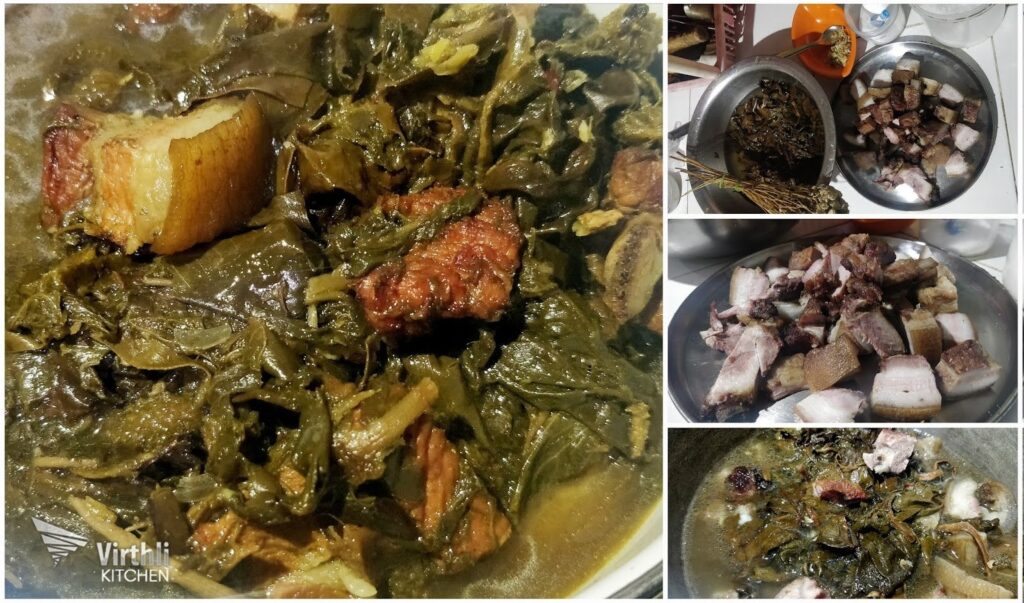
The Unique Ingredients and Their Significance
When we talk about the mouthwatering dish of Smoked Pork (Vawksa Hro) with Taro Leaves (Dawl Hro), it’s essential to look a bit deeper into the key ingredients that make this dish so special. These ingredients are not just chosen for their flavors but also represent a cultural significance and a bond with the land.
1. Smoked Pork:
The art of smoking meat, especially pork, has been a tradition in many cultures around the world. In Northeastern India, this method isn’t just about flavor; it’s a necessity. Given the region’s varied climate, smoking becomes an effective way to preserve the meat for longer periods. The process involves exposing the pork to smoke, which not only acts as a preservative but also infuses the meat with a rich, smoky flavor that’s hard to replicate. This smokiness becomes the backbone of many dishes, offering a taste that’s both rustic and deeply satisfying.
2. Dried Taro Leaves (Dawl Hro):
Taro is a staple in many Asian cuisines, known for its starchy roots. However, in Northeastern India, its leaves hold a special place. When dried, these leaves, known locally as Dawl Hro, bring an earthy depth to dishes. Beyond the flavor, taro leaves are packed with nutrients. They are a good source of vitamins, minerals, and fiber, making them not just tasty but also beneficial for health. In the context of our dish, these leaves beautifully balance the rich smokiness of the pork, creating a harmony of flavors.
3. Elsholtzia blanda (Pleasant Himalayan Mint) – Lengmaser:
This herb, while not as globally recognized as the other ingredients, is a gem from the Himalayan region. Known locally by various names like Lengmaser and Lomba, Elsholtzia blanda is a small herb with a big impact. Its leaves, when dried and added to dishes, introduce a subtle minty note, elevating the overall taste. But it’s not just about flavor; this herb is known to have health benefits too. Consuming it can help in reducing blood pressure, making it a blend of taste and wellness.
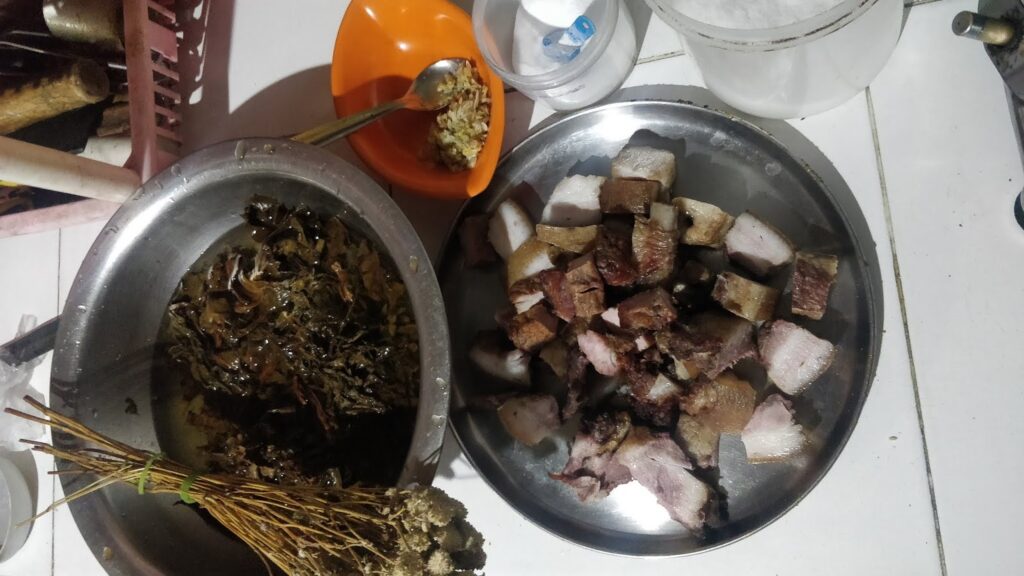
Preparing the Ingredients
Making Smoked Pork with Taro Leaves is an experience that starts even before the actual cooking begins. Preparation plays a big role in ensuring the dish turns out delicious. Here are some handy tips to get started:
Soaking Taro Leaves
Dried taro leaves can be tough. Soaking them in water softens them, making them easier to cook and eat. It’s a good idea to soak them overnight or at least for a few hours before cooking. This ensures they become tender and release their flavors into the dish.
Checking the Smoked Pork
While smoked pork is preserved, it’s still essential to ensure it’s fresh and of good quality. When buying, look for a nice color and a pleasant smoky aroma. Avoid pork that smells off or looks discolored.
Ginger-Garlic Mix
This mix is often used in many dishes to enhance flavor and reduce any strong smells, especially from meats. Preparing a fresh mix of ginger and garlic rather than using store-bought pastes can make a big difference in flavor. Simply grind equal parts of ginger and garlic to make a smooth paste.
Step-by-Step Cooking Process
Once you’ve got your ingredients ready, it’s time to get right into the cooking process:
- Start with the Pork: Begin by cooking the smoked pork in water. This helps soften the meat and make it juicier. About 20 minutes should do.
- Flavor Time: Add the ginger-garlic mix to the pot. This step helps in reducing any strong porky smells and introduces a lovely base flavor.
- Add Taro Leaves: Now, it’s time to add the previously soaked taro leaves. Give everything a good stir, ensuring the leaves mix well with the pork.
- Spice it Up: Add dried chili flakes for that kick. Adjust according to your spice preference.
- Finishing Touches: Once the taro leaves soften, it’s time to add the Elsholtzia blanda. This herb will give a minty freshness to the dish. After everything’s mixed well, let it cook for a few more minutes, and you’re done!
- Serve: This dish tastes best hot, preferably with a side of rice.
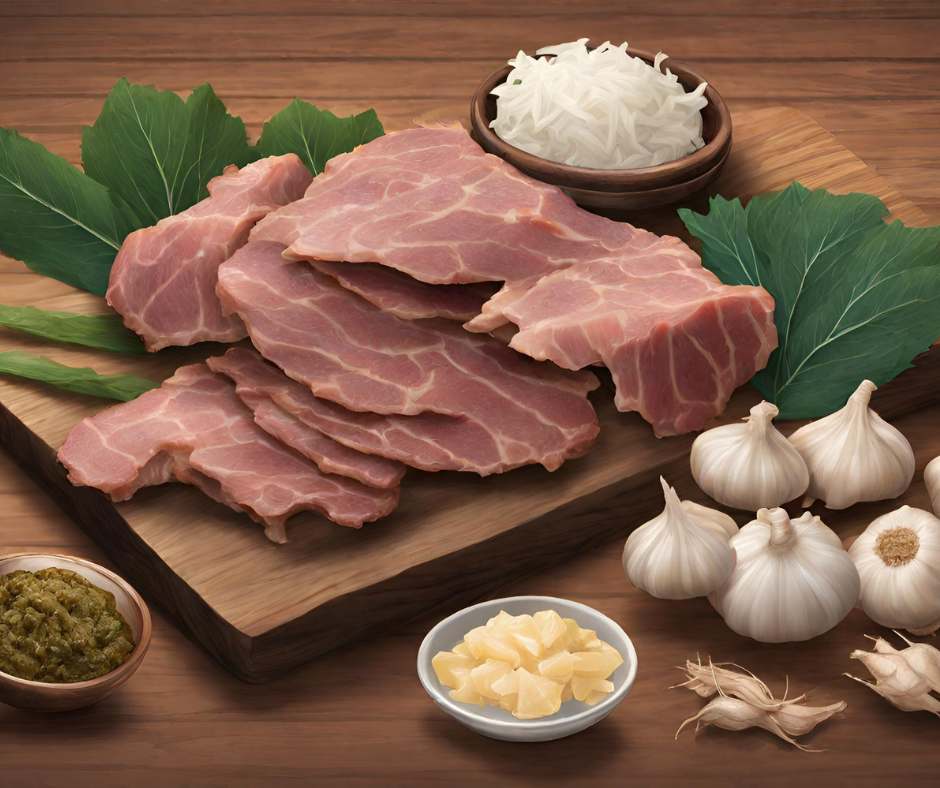
Variations and Customizations
Every dish can be tailored to personal preferences, and Smoked Pork with Taro Leaves is no exception:
Herbal Touch: Apart from Elsholtzia blanda, feel free to experiment with other local herbs. They can introduce new flavors and make the dish even more exciting.
Adjusting Spice Levels: Not everyone likes their food too spicy. If you prefer a milder version, reduce the chili flakes or use a milder chili variety.
Vegetarian Version: While smoked pork is the star of this dish, for those who don’t consume meat, replacing pork with a hearty vegetable like eggplant or mushrooms can be an option. The key is to retain the flavors of taro leaves and herbs.
Remember, cooking is as much about experimenting as it is about following recipes. Feel free to tweak and make this dish truly your own!
Serving and Pairing Suggestions
When it comes to enjoying the rich flavors of Smoked Pork with Taro Leaves, presentation and pairing can elevate the dining experience.
Serving the Dish: The beauty of this dish lies in its vibrant colors and aromatic appeal. Serve it hot in a deep bowl or wide dish to showcase the mix of ingredients. A sprinkle of fresh herbs or a garnish of chopped fresh Lengmaser can add an extra touch of color.
Pairing Recommendations: This hearty dish pairs well with several accompaniments. Steamed rice complements the robust flavors. For those wanting a different grain, consider quinoa or millet. Side dishes like cucumber salad or a tangy tomato chutney can balance out the richness of the pork. If you’re looking for a drink pairing, light green tea or a citrusy drink can cleanse the palate and prep you for the next delicious bite.
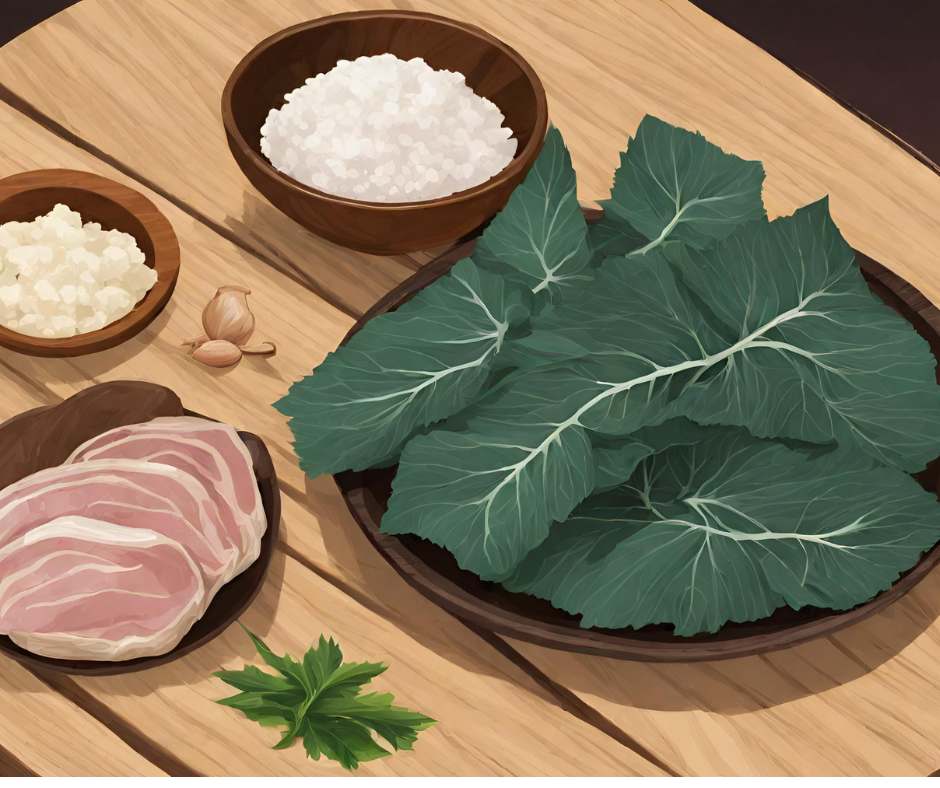
Health Benefits and Nutritional Insights
Beyond its delightful taste, Smoked Pork with Taro Leaves brings a bundle of nutritional benefits to the table.
Smoked Pork: Pork is a good source of protein and essential vitamins like B12. However, moderation is key as smoked meats can be high in sodium.
Taro Leaves: These leaves are packed with vitamins and minerals. They are especially rich in Vitamin C, Vitamin A, and dietary fiber. Additionally, they provide a good amount of calcium and potassium.
Elsholtzia blanda: This herb isn’t just for flavor. Known for its ability to help reduce blood pressure, it’s a healthful addition to many dishes. Moreover, its minty freshness aids digestion.
Storing and Reheating
Enjoying the dish fresh is best, but if you have leftovers, here’s how to store and reheat them:
Storing: Keep leftovers in an airtight container and refrigerate. It’s best to consume them within 2-3 days for optimum flavor.
Reheating: When ready to eat, reheat on the stove over low-medium heat until warmed through. Avoid using the microwave as it can alter the dish’s texture. Add a splash of water if the dish seems too dry during reheating.
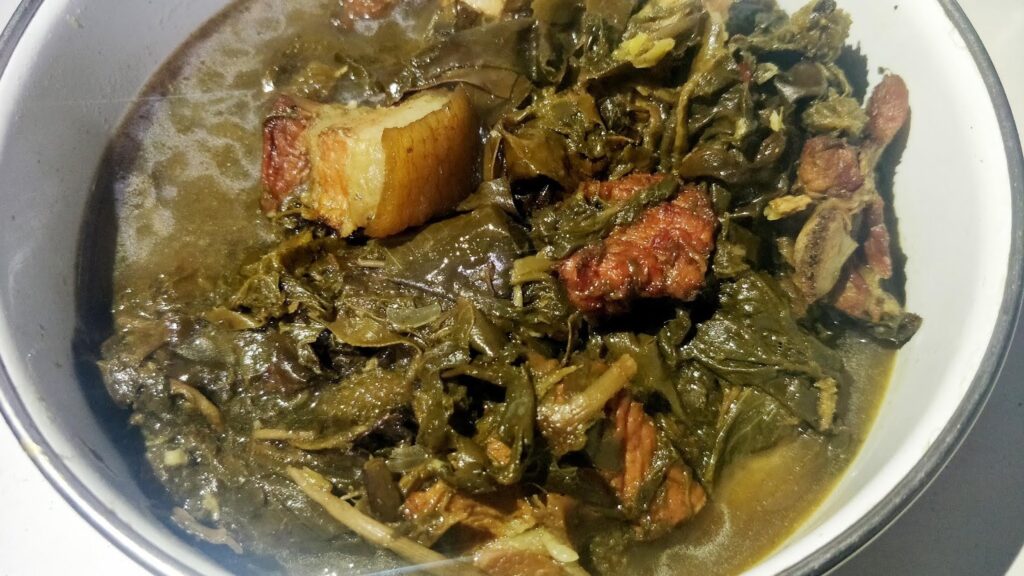
FAQs: Vawksa Hro le Dawl Hro (Smoked Pork with Dried Taro Leaves)
- Can I use fresh taro leaves?
Absolutely not! Fresh taro leaves tend to leave tingling feeling in the mouth and may cause allergic reactions. One absolutely must sun dry it first. - Is there an alternative to smoked pork?
While smoked pork is the traditional choice, you can experiment with smoked beef or even tofu for a vegetarian version. You can also use fresh pork for this dish. - Can I use store-bought ginger-garlic paste?
While homemade paste is recommended for its fresh flavor, store-bought can be a time-saving alternative.
Remember, cooking is all about experimentation and enjoying the process. Happy cooking!





